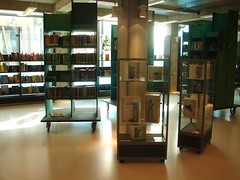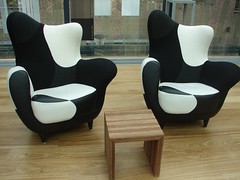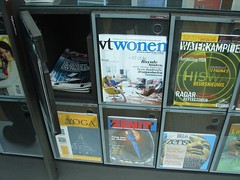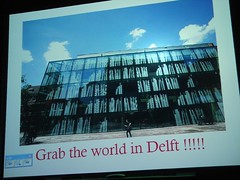from:
Janene Pieters, “Mystery of world-famous Vermeer setting finally solved”
Nov. 19, 2015
NLTIMES.NL
http://www.nltimes.nl/2015/11/19/mystery-of-world-famous-vermeer-setting-finally-solved/
The century-old mystery of the exact location of Johannes Vermeer’s painting Little Street, has finally been solved. The setting for the world-famous painting is on Vlamingstraat in Delft, where houses 40-42 now stand.
This extraordinary revelation was made by Dr. Frans Grijzenhout, professor of Art History at the University of Amsterdam, the Rijksmuseum announced on Thursday.
Grijzenhout searched 17th-century records in the Delft archives and found the conclusive answer in The file of the deep waters within the city of Delft from 1667, also called the Register of the quayside fee. This register kept record of how much tax everyone who owned a house on a canal in Delft had to pay for the deepening of the canal and for maintenance of the wharf in front of his door. It contains detailed, accurate up to 15 cm, information on the breath of all the houses and ports on the Delft canals in Vermeer’s time.
The two houses that then stood on Vlamingstraat where numbers 40-42 are now located, completely correspond with The Little Street. No other houses from Vermeer’s time correspond so exactly.
The research also revealed that Vermeer’s aunt—the widow Ariaentgen Claes van der Minne, Vermeer’s father’s half-sister —lived in the house on the right side of the painting. Vermeer’s mother and sister lived on the same canal, diagonally across the street. According to the Rijksmuseum, it is therefore likely that Vermeer knew the house well and had personal memories linked to it.
“The answer to the question of where Vermeer’s Little Street is located, is of great significance and will have profound consequences, bot for the way we look at this one painting by Vermeer as well as for the image we have of Vermeer as an artist”, said Pieter Roelofs, curator of 17th-century paintings at the Rijksmuseum.
To celebrate theLittle Street’s address being found, the Rijksmuseum is dedicating an exhibition to the discovery. The exhibition will be in the Rijksmuseum between November 20th of this year and March 13th, 2016.
TRIPE GATE
from the Rijksmuseum website:
The houses now on the site were built in the last quarter of the nineteenth century. The only aspect that can still be recognized as it appears in The Little Street is the striking gate and passageway on the right. The investigation also revealed that the house on the right in The Little Street belonged to Vermeer’s widowed aunt, Ariaentgen Claes van der Minne, his father’s half-sister. She earned her living and provided for her five children by selling tripe, and the passageway beside the house was known as the Penspoort—Tripe Gate.
Google Art Project presentation:
https://www.google.com/culturalinstitute/exhibit/sgLy5pT_lFc9IQ?projectId=art-project&position=0%3A0
Rijksmuseum presentation:
https://www.rijksmuseum.nl/en/vermeers-the-little-street-discovered
A special exhibition about the newly found location of Vermeer’s Little Street will be held in two venues:
Rijksmuseum, Amsterdam
20 November 2015-13 March 2016
Stedelijk Museum Het Prinsenhof, Delft
25 March-17 July 2016
Patrick van Mil, Director of Museum Prinsenhof Delft, says “This offers the opportunity to put Delft on the map as the Vermeer City. With new routes through the city, a special virtual reality App, Vermeer packages etc. We bring the Vermeer of Delft for the visitors to life. To achieve this we are looking for cooperation with various parties such as the Oude Kerk, the Vermeer Centre, TU Delft, Delft Marketing and business. Together we can develop an attractive program whereby Delft would again be dominated by Johannes Vermeer and ‘The Little Street’, Delft, Vermeer and Vermeer’s Delft!”
“Most rare workmen”: Optical practitioners in early seventeenth-century Delft”
Huib J. Zuidervaart and Marlise Rijks
The British Journal for the History of Science, pp. 1 – 33, (March 2014)
online article can be accessed at:
http://journals.cambridge.org/action/displayAbstract?fromPage=online&aid=9202672&fileId
=S0007087414000181
abstract:
A special interest in optics among various seventeenth-century painters living in the Dutch city of Delft has intrigued historians, including art historians, for a long time. Equally, the impressive career of the Delft microscopist Antoni van Leeuwenhoek has been studied by many historians of science. However, it has never been investigated who, at that time, had access to the mathematical and optical knowledge necessary for the impressive achievements of these Delft practitioners. We have tried to gain insight into Delft as a ‘node’ of optical knowledge by following the careers of three minor local figures in early seventeenth-century Delft. We argue that through their work, products, discussions in the vernacular and exchange of skills, rather than via learned publications, these practitioners constituted a foundation on which the later scientific and artistic achievements of other Delft citizens were built. Our Delft case demonstrates that these practitioners were not simple and isolated craftsmen; rather they were crucial components in a network of scholars, savants, painters and rich virtuosi. Decades before Vermeer made his masterworks, or Van Leeuwenhoek started his famous microscopic investigations, the intellectual atmosphere and artisanal knowledge in this city centered on optical topics.
Especially of interest is the authors’ tie between three optical practitioners who lived in Delft simultaneously with Vermeer. One of them, Jacob Spoors, was in 1674 the notary of Vermeer and his mother-in-law Maria Thins. Another was an acquaintance of Spoors, the military engineer Johan van der Wyck, who made an optical device in Delft in 1654, most likely a camera obscura. A report about the demonstration in nearby The Hague has been preserved. Van der Wyck also made telescopes and microscopes and an apparatus that probably was a kind of perspective box. As a telescope maker he was preceded by Evert Harmansz Steenwyck, brother-in- law of the Leiden painter David Bailly and father of two Delft still-life painters: Harman and Pieter Steenwyck. The latter was familiar with Vermeer’s father Reynier Jansz Vermeer, at a time when the young Vermeer was still living with his parents. According to the authors, this is the first real archival evidence that such a device existed in Delft during Vermeer’s life.
 Earlier this month I had the incredible good fortune to visit DOK in Delft, Holland. Normally I would call it the Delft Public Library, but it just goes by the name “DOK” and the sign on the door says it’s a “library concept center.” The staff did this on purpose to get away from the traditional stereotypes of the public library, because the institution they’ve created is about as far away as you can get from the connotation of a 1950s building, filled with quiet people, all of them sitting alone, in a relatively dreary building, being shushed by an old lady with a bun.
Earlier this month I had the incredible good fortune to visit DOK in Delft, Holland. Normally I would call it the Delft Public Library, but it just goes by the name “DOK” and the sign on the door says it’s a “library concept center.” The staff did this on purpose to get away from the traditional stereotypes of the public library, because the institution they’ve created is about as far away as you can get from the connotation of a 1950s building, filled with quiet people, all of them sitting alone, in a relatively dreary building, being shushed by an old lady with a bun.
 Instead, it is easily the most colorful and aesthetically-pleasing library I have ever seen. Granted, I’ve seen a very small percentage of the world’s libraries, but the use of a diverse palette of bright and unusual colors was a very stark contrast to every other library I have seen in person or in pictures.
Instead, it is easily the most colorful and aesthetically-pleasing library I have ever seen. Granted, I’ve seen a very small percentage of the world’s libraries, but the use of a diverse palette of bright and unusual colors was a very stark contrast to every other library I have seen in person or in pictures.
Even more impressive (and truly striking) is the amount of radical trust the staff has placed in its patrons. Some of the stark contrast with American libraries is due in part to the litigious nature of our society. Everywhere I went in Delft and in DOK, I found examples of things we could never do in the U.S. out of fear of being sued out of existence. In some cases, it’s as simple as having some of the shelves for childrens books and display cases on wheels so that they can be moved around as needed to create program or play space. The kids can even stand on the bookshelves (as can adults). There’s a room that’s tucked away on the side that truly is built for children, with low benches for sitting and lighting underneath them for little ones who want to read or play on the floor. In another case, it’s the open listening station pods. When I was there, I could hear music drifting through the building from one of them. Some kids would put on an album and let it run while they were elsewhere on the floor talking or playing videogames. It wasn’t overwhelming, though, and there were other places where I couldn’t hear it at all and could sit in silence if I wanted to.



The small design touches everywhere are stunning, but that’s not surprising giving the Dutch aesthetic. DOK easily has the coolest, most comfortable chairs of any library. As I walked around, I kept sitting in them just because I could and wanted to. Some of them are even practical. Recently, I was in a public library in the U.S. where I had trouble finding a comfortable place to sit. My only choice as an adult was the standard box cushion chair with wood arms. Compared to DOK, furniture used in American libraries is at best corporate and at worst unwelcoming. They also use natural language names for sections of the collection (psychology, computers and internet, etc.), not Dewey numbers, and the graphics for the banners are colorful and eye-catching. They are clearly done by a professional, and they don’t all look the same. Also note the lack of steel shelves that make the library look like a warehouse. Instead, they used flexible shelving made from recyclable materials (also done for some gorgeous tables and desks).



 You walk into DOK and you immediately feel welcome into a place you know you can spend hours at if you want to. DOK is what I’ve always wanted libraries to be in terms of the “experience” that happens around books, information, content, media, and people. You can’t help but smile when you’re inside, and you just feel happier in general. A couple of years ago, I heard a speaker at a Minnesota Library Association conference say that the classic mistake libraries make is that we focus too much on how we want people to feel about the library when they walk in. His theory was that we need to focus on how people feel about themselves when they walk in, and DOK illustrates that theory in practice. Each time I entered the building, the bright, natural light from the glass ceiling had an effect on me. If I feel better about myself there, I will feel better about the library and enjoy my experience more.
You walk into DOK and you immediately feel welcome into a place you know you can spend hours at if you want to. DOK is what I’ve always wanted libraries to be in terms of the “experience” that happens around books, information, content, media, and people. You can’t help but smile when you’re inside, and you just feel happier in general. A couple of years ago, I heard a speaker at a Minnesota Library Association conference say that the classic mistake libraries make is that we focus too much on how we want people to feel about the library when they walk in. His theory was that we need to focus on how people feel about themselves when they walk in, and DOK illustrates that theory in practice. Each time I entered the building, the bright, natural light from the glass ceiling had an effect on me. If I feel better about myself there, I will feel better about the library and enjoy my experience more.
 DOK’s Director, Eppo, told us that “libraries are (for the most part) all about not having fun.” At DOK, they deliberately turned this stereotype on its head. Instead, their theory is that “life is all about having more fun than you can think of, and it starts at the library.” So they have videogames, listening stations, comfortable chairs, a cafe, a circulating art collection, programs throughout the building (not just hidden away in a room in the basement), a piano, toys for kids to play with, a brightly-lit room devoted to graphic novels, an entire room (done in red) devoted to romance novels, and more.
DOK’s Director, Eppo, told us that “libraries are (for the most part) all about not having fun.” At DOK, they deliberately turned this stereotype on its head. Instead, their theory is that “life is all about having more fun than you can think of, and it starts at the library.” So they have videogames, listening stations, comfortable chairs, a cafe, a circulating art collection, programs throughout the building (not just hidden away in a room in the basement), a piano, toys for kids to play with, a brightly-lit room devoted to graphic novels, an entire room (done in red) devoted to romance novels, and more.
 When you walk in the building for the first time, if your cellphone is discoverable via bluetooth, you’ll receive a text message from DOK that says, “Welcome to the most modern library in the world,” a claim well-lived up to. There’s an RFID system for both library cards and books (with no privacy problems to date). There’s a system of LCD screens mounted around the building for navigation and information which runs off Nintendo Wiis. The display is a Flash application of a Wii channel and the top bar’s information and color changes based on your location in the library. Staff can log in to a website to change what shows on the display in order to update messages for the public (about programs, closings, etc.). The afore-mentioned listening station pods are truly amazing, and I now have to find a way to fund one for my home. Plans for later this year call for the installation of a multimedia creation area for podcasting/vidcasting/etc. and a “genius bar” type of setup for technology help for the public.
When you walk in the building for the first time, if your cellphone is discoverable via bluetooth, you’ll receive a text message from DOK that says, “Welcome to the most modern library in the world,” a claim well-lived up to. There’s an RFID system for both library cards and books (with no privacy problems to date). There’s a system of LCD screens mounted around the building for navigation and information which runs off Nintendo Wiis. The display is a Flash application of a Wii channel and the top bar’s information and color changes based on your location in the library. Staff can log in to a website to change what shows on the display in order to update messages for the public (about programs, closings, etc.). The afore-mentioned listening station pods are truly amazing, and I now have to find a way to fund one for my home. Plans for later this year call for the installation of a multimedia creation area for podcasting/vidcasting/etc. and a “genius bar” type of setup for technology help for the public.
None of which precludes the provision of and help finding print materials and reference help. Staff are smartly situated throughout the building, and books are everywhere. Magazines and newspapers are easily accessible, housed in a brilliant design of cubes that makes the most current edition visible and recent issues available without staff intervention. While there are flyers and handouts on top of various shelving, the walls are not plastered with handmade signs of rules and navigation. Of course, there isn’t a single “no cell phones” sign to be found since they actually communicate with patrons via mobile devices.



I could go on all day about how DOK gets the big things and the details right, but you can see some of this for yourself in my Flickr set. It is everything the big, fancy American libraries want to be but just miss. If your library is planning a new building or a renovation, I highly recommend you talk to the people at DOK and if at all possible, visit this amazing library. You will be amazed at how much better than a bookstore a library can be at merchandising and aesthetics, let alone the social experience.
delft,
dok,
public library,
the most modern library in the world

















